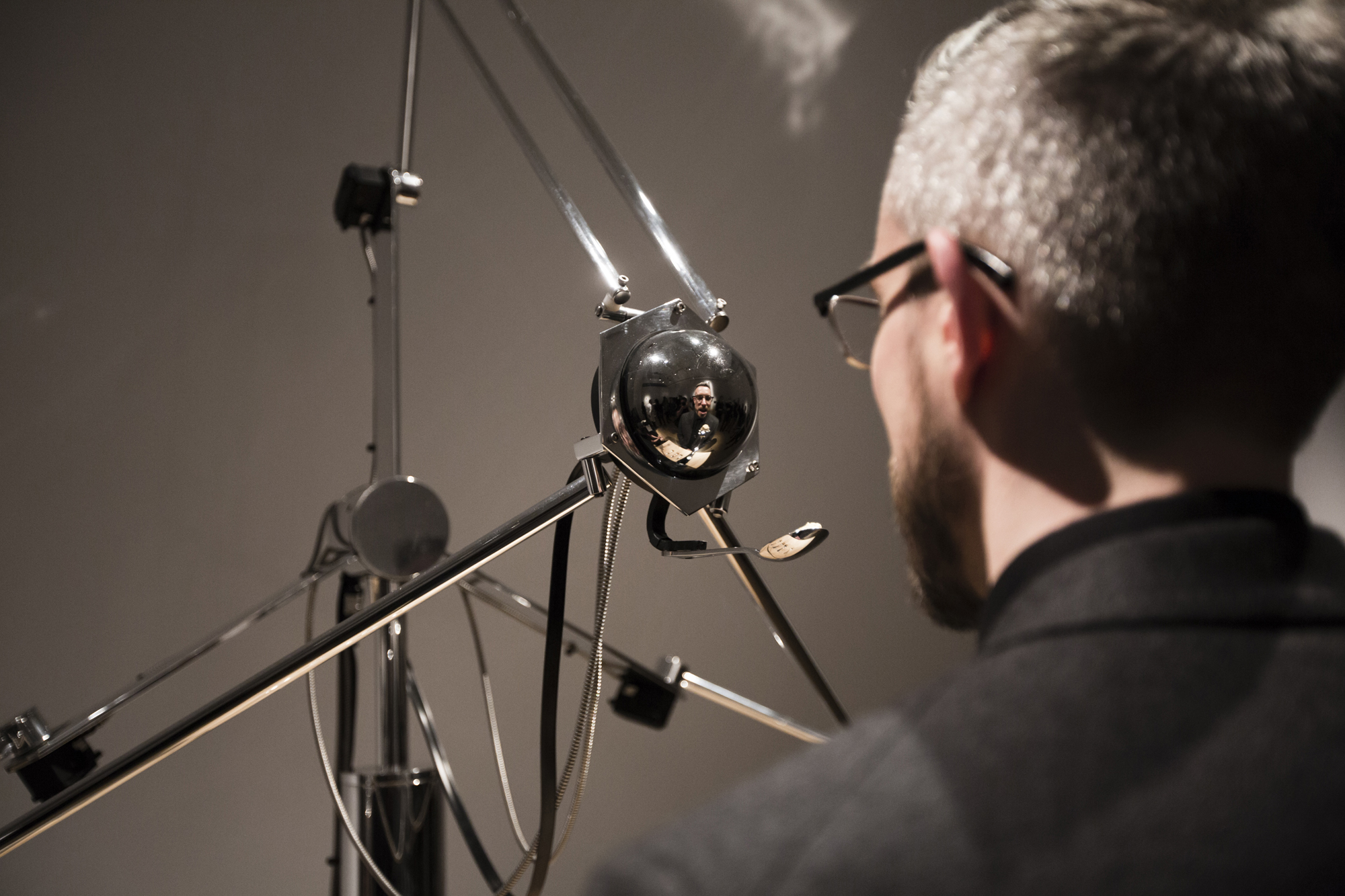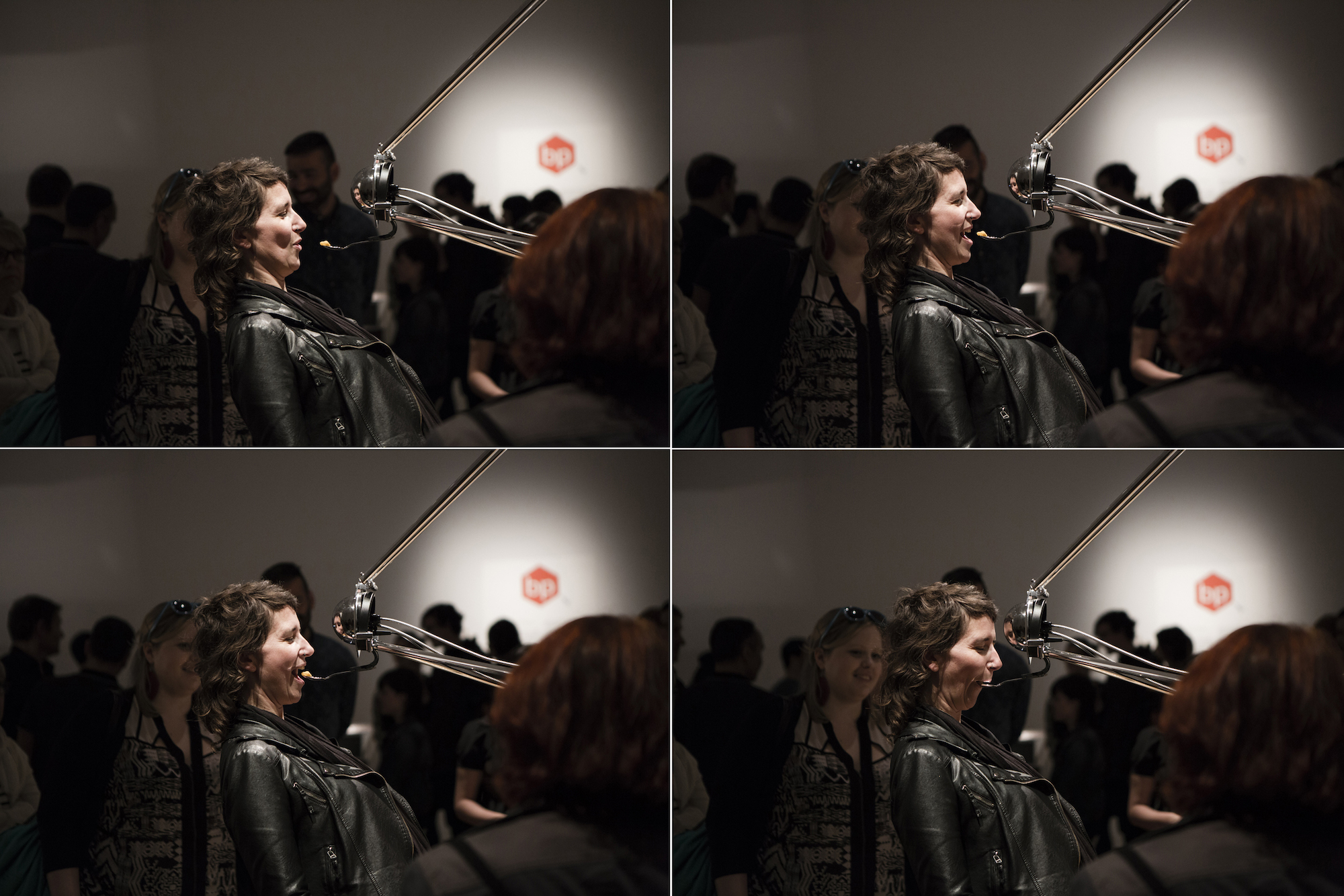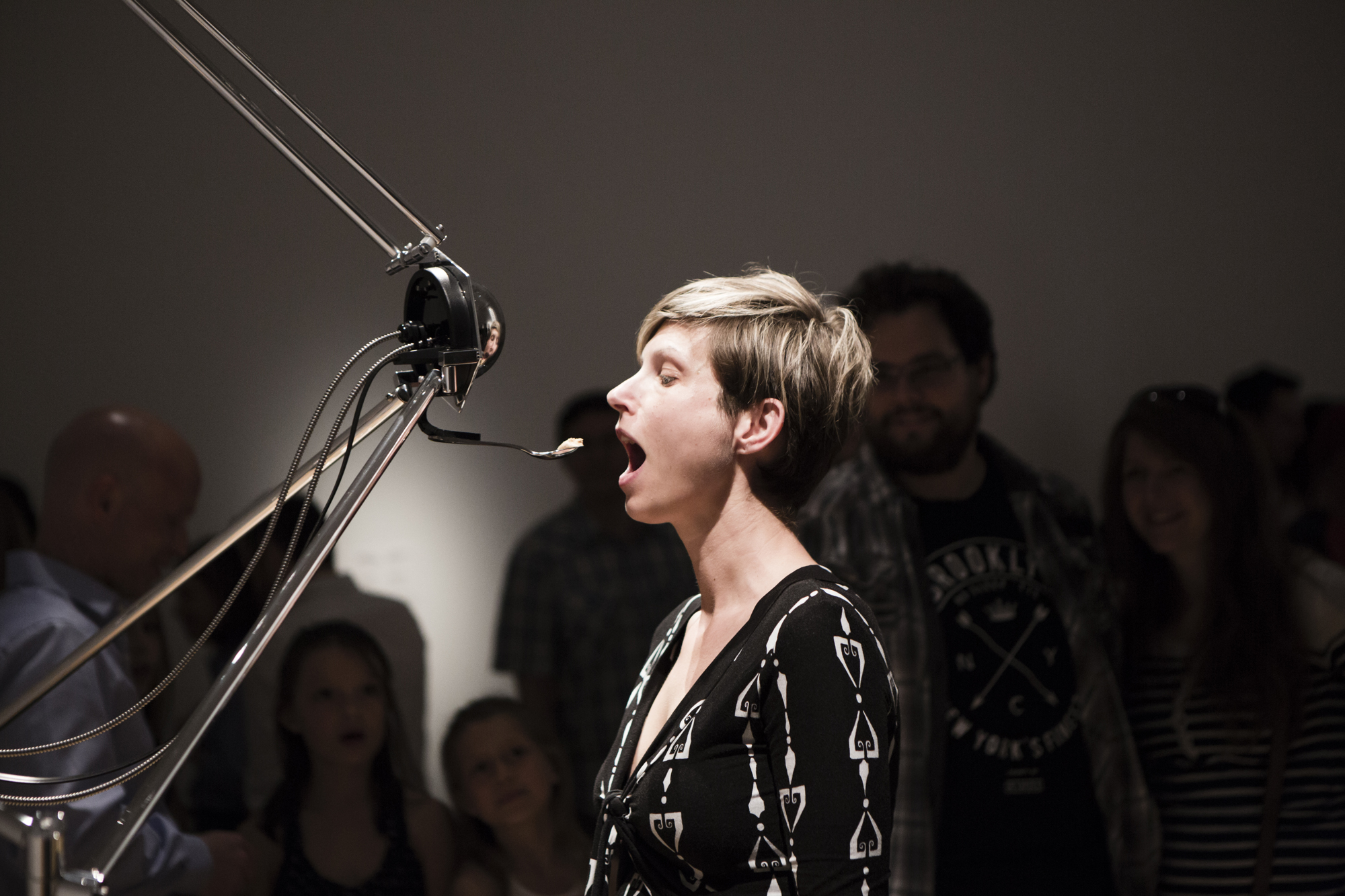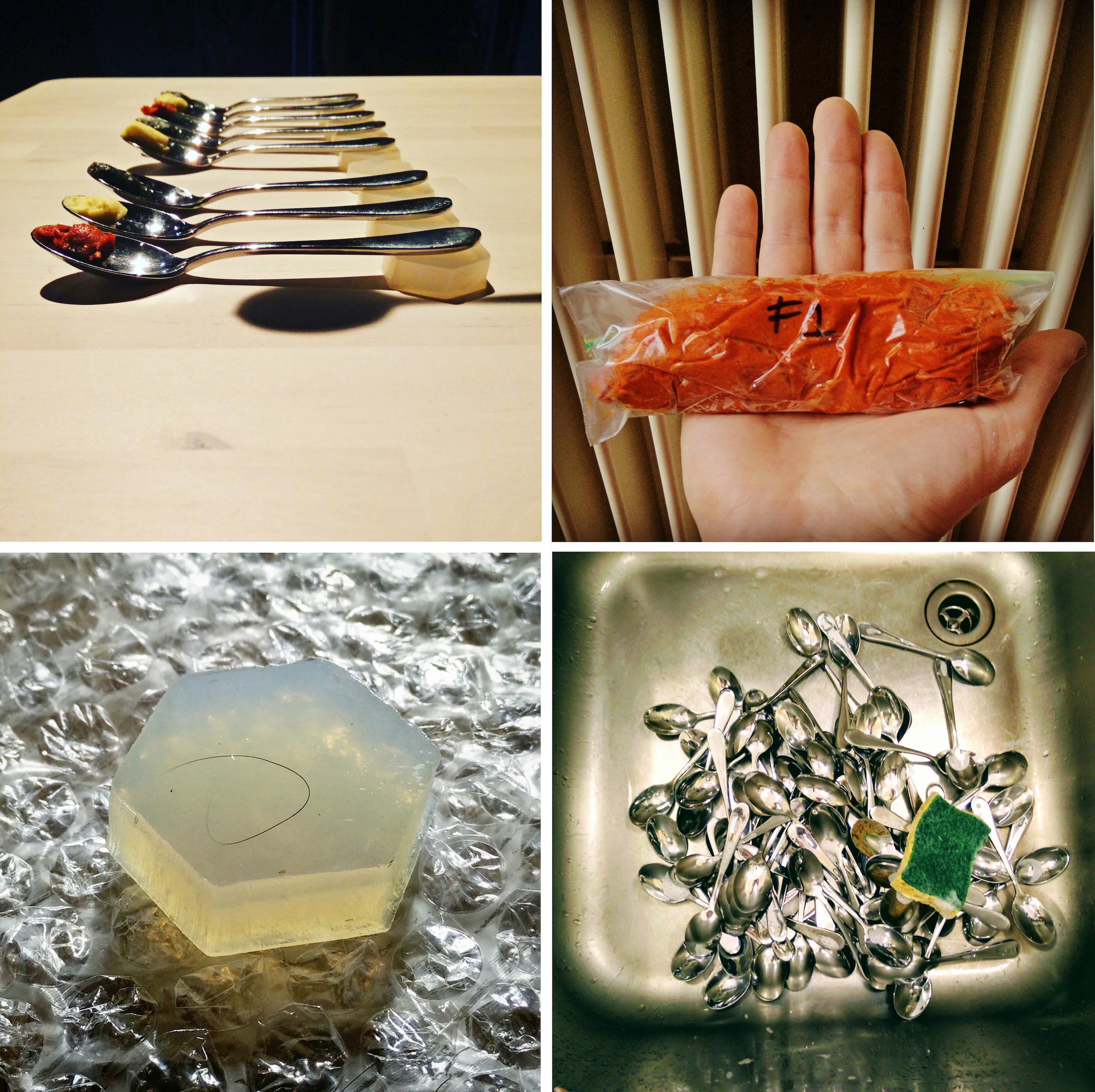By: Allison Norris
Imagine standing in front of a machine waiting to be fed by it. Three lanky metal arms converge to a centre-point which offers a spoon, half full of an unknown paste. The spoon hovers in front of your lips. How do you negotiate this offering? What does it mean to accept?

Credits: Gridspace.
During their presentation at the Food Matters and Materialities conference, David Szanto and Simon Laroche explored the entangled relationships of food, technology, and human agency by discussing their Perpetual Demotion installation, featured in eight exhibitions since 2014.
Orchestrer la perte/Perpetual Demotion is an interactive food and robotic art installation. The robot senses when a human stands in front of it and is programmed to pick up a spoon of edible paste, locate the human’s face via an internal camera, and place the spoon directly in front of the human’s mouth.

Credits: Gridspace.
David Szanto, an artist, teacher, researcher, and food consultant, met media artist and teacher Simon Laroche through a mutual friend. The two of them quickly realized there were ideas and concepts they could develop together. Perpetual Demotion started to take shape after viewing industrial farming videos and having conversations about parallels between feeding animals and the way social media feeds content to humans.
“I remember having a great desire to build a feeding robot,” recalls Simon, but the installation is about much more than the robot itself. David and Simon point out that the meaning of the installation is derived from the human experience of interaction with the robot, which confronts how humans are both nurtured and dominated by the blending of digital technology and food.
People are already nurtured by technology in various ways, which David and Simon say has its own complications. Simon offers Google Maps as an example. While the app helps humans navigate geographical space more quickly, they might also lose the ability to navigate on their own. He says the same can be said about canned foods, premade meals, meal kits, etc. Somewhere along the way, people can lose their sense of ingredients, proportions, and flavouring.
“In my work, I’ve thought about the intersubjectivity of humans and food,” says David. “We make it, and it makes us.” He recalls conversations with Simon about some of the ways people are enslaved or harnessed to technology and how there is a two-way feeding relationship, for example, between human beings and their smartphones. “This led to conversation about refining the theme: domination and nurturing.”
“That is where we started crystallizing the idea of getting people and a robot in the situation where they would have to interact with one another,” Simon adds. “And having a robot perform this intimate gesture, probing or getting inside people’s mouths.”
“What can we do to get that machine really as close to being embedded inside the human as possible?” asked David. “If it is holding a piece of food, that is the perfect bait.”
This may sound intrusive or even ominous, but the human participants are willing participants of all ages who open their mouths and lean forward to accept what is offered. David and Simon characterize the robot feeding a human as a familiar act, reminiscent of being fed as a child. But the outsourcing of feeding or nurturing to a robot complicates more general ideas around technology and care.

Credits: Gridspace.
“We had been reading about the outsourcing of elder care to robots, even a robot being placed in the room [with] someone to keep them company,” explains David. “When the institution takes over the care of our loved ones, whether they are young or old or in between, we are really deconstructing society pretty fundamentally at that point – generations are not caring about each other. That is an extreme version, obviously, but it was something that triggered the idea to confront our audience.”
“There is no ‘free labor’ producing care,” notes Simon. “The robots are not working for free. The robots or the apps ‘working’ are tools of conglomerates that produce them, in a capitalist frame of mind where some people are the owners of these tools, some are not. These owners need to make money. They make the tools and determine the way in which we get the care or consume products. The money or the payment of that labor is still circulating in specific circles, directing our own experience of being cared for.”
“When will we have an app that tells us how the food tasted after we have swallowed it?” asks David. “We won’t even need to use our own sensory organisms to determine whether we liked something or not.”
Technology disguises or conceals the labour and care put into producing food, but also food systems. Most people are unable to remember the first time someone fed them or the acts of care that went into preparing their first foods. Even as people grow, few pay attention to the origins of their food. Fittingly, the pastes offered by the robot in Perpetual Demotion are unidentifiable in appearance, texture, and taste, and participants are given no choice as to which they might receive.

Credits: Gridspace.
“Individuals are being ‘deskilled’ at an alarming pace,” says David. “People genuinely don’t know where their food comes from or what to do with it. In my mind, what is more important than feeding yourself? That is a fundamental act that humans do. And if we are freed up from having to do that, what are we spending our time on? What are spending our energy on?”

Credits: David Szanto.
The intention of this installation is not necessarily to answer the myriad of questions it raises, but rather to draw people’s attention to the relationships between technology, food, and humans. David and Simon also want to underscore how technology can disconnect humans from larger, more complex systems. David and Simon ask how simple acts of consuming convenience food – David gives the example of opening a bag of chips – are connected to the economy and global networks.
“I want attention drawn to the invisible,” says David. “The objective of my work is attention, awareness, and engagement, in order to build towards creativity, empowerment.”
“The word awareness speaks to me very clearly too,” agrees Simon. “How can people take away from this experience elements that they will use to look at their own lives?”
“In some ways, food and technology have become each other. We eat GMOs – we are inserting technologies straight into our bodies,” says David. “There is so much integration, hybridization, and cyborgization of food, humans, and technology. If we have created a sense of understanding the relationality between these three different actors, then maybe it’s time to go inside. And, if we are going to go inside, how do we do that?”